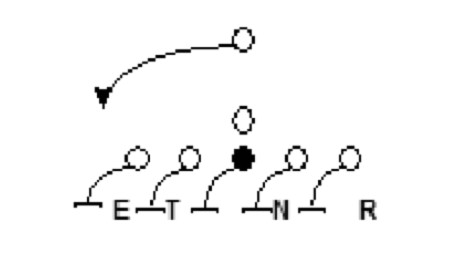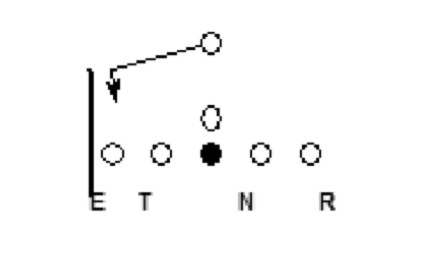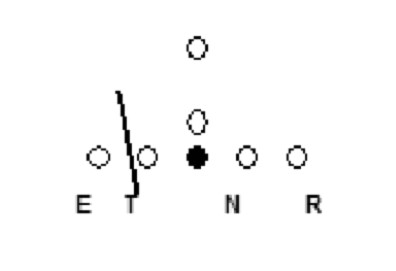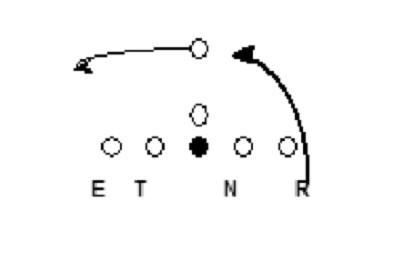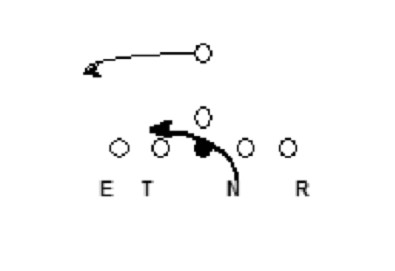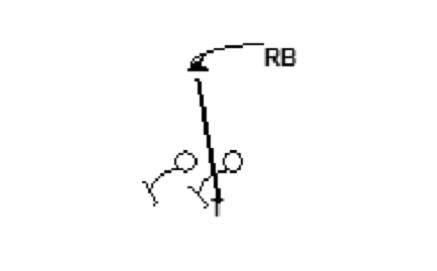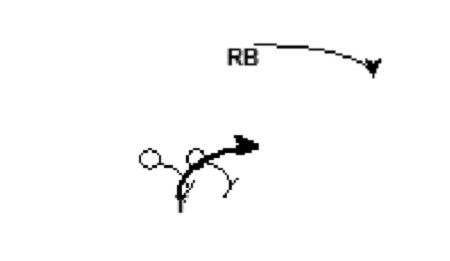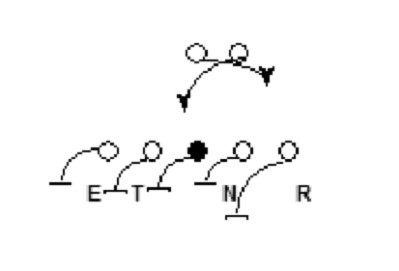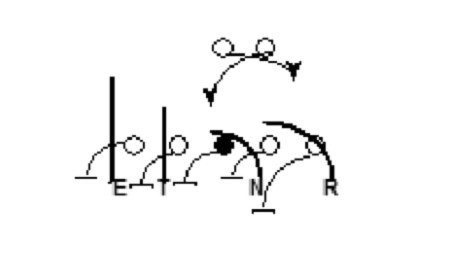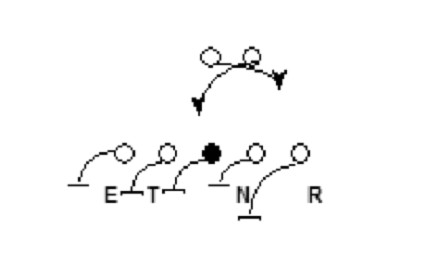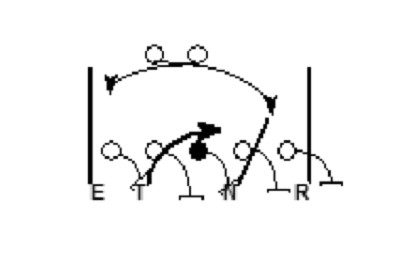Article CategoriesAFM Magazine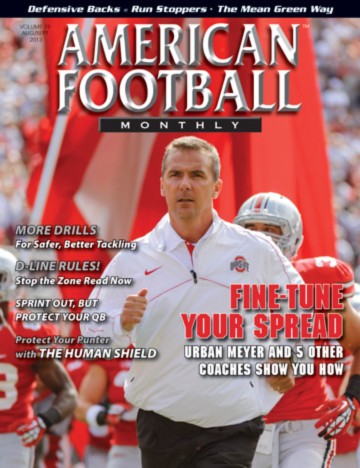
|
D-Line Rules vs. Outside Zone and Zone Readby: Ray DeFriscoDefensive Coordinator • Illinois College © More from this issue Following the playside and backside rules is critical to stopping the outside zone and zone read. We try to keep our D-line rules and principles the same with outside zone and zone read as well as other plays and concepts. When we speak about outside zone, we break into halves, especially what side the offense is on in pre-and post-snap. We use strength and if the quarterback is under center or in the gun to determine the run strength of this particular play. Otherwise, we may use the tight end to determine run strength.
Diagram 1. In diagram 1, outside zone is run from under center and we are in the over front. It doesn’t matter which direction the play goes, or if it is toward or away from strength. Each side has the same responsibilities depending on the direction of the play. When the outside zone goes to the left, the end and tackle are the play side, and the nose and rush are the back side. Playside rules (outside): the end or rush (in this case the end) is responsible for forcing the play, or changing the direction of the running back as illustrated in diagram 2. He wants to maintain his leverage and beat the running back to the spot. The spot is determined at the depth of the ball, keeping the running back inside of the end. We use a bull rush/push pull combo vs. this play to change the direction of the ball carrier.
Diagram 2.
Diagram 3. Playside rules (inside): the nose or tackle (in this case the tackle) is responsible for penetrating the backfield. He wants to run through his lineman to the spot. We strictly use the bull rush for this technique. Diagram 3 shows the tackle getting to the spot. The tackle must run his feet, maintaining his leverage through the outside shoulder of the guard. Backside rules (outside): the end or rush (in this case the rush) is responsible for trail. He must close down his gap, then gain depth as the play goes away. He trails as deep as the ball and is responsible for the bootleg, reverse, or deep cutbacks. The rush will adjust his depth as the depth of the ball adjusts. In diagram 4, the running back has the ball and is running away while the rush is keeping proper relation to trail the ball.
Diagram 4. Backside rules (inside): the tackle or nose (in this case the nose) is responsible for the cutback. He must close his gap, afterwards keeping the running back inside and in front. The nose must stay at heel level in order to ensure a tackle on the running back if he cut backs. Diagram 5 illustrates the proper depth; if
Diagram 5. Our rules are the same when the zone goes in either direction. We use these techniques and marry our run-through lanes for linebackers based of the responsibilities of the defensive line. The scheme we use allows us to practice a two-on-one drill in either direction with any player. They must properly execute the correct technique and responsibility. This is the setup of the drill in diagrams 6 and 7. Each D-lineman will do this drill from their respective alignments. The coach will direct the offense so the defense does not know the direction of the play prior to the snap. This drill is used for each defensive lineman.
Diagram 6.
Diagram 7. There are many different theories on how to defend zone read but there are just two simple ways that fit our scheme. We first determine which player is more of the running threat or the one we want to carry the ball, and if there is a triple option threat (zone read pass). We feel we can dictate the read of the quarterback by our assignments. After determining these questions, we will defend zone read by either taking away the quarterback or the running back. Our front, either over or under, will marry up with the back we are attacking. When attacking the RB, we give the read side a one technique (nose), and a five technique (rush), or end, depending on the call. The inside linebackers must know which assignment our defensive line has, and, by the call from the sidelines, they can adjust the front if needed from an over to an under with a “Bump” call. When we attack the quarterback, we give the read side a three and five technique. In diagrams 8 and 9, we are forcing the quarterback’s read to be a keep. We would either roll a safety down, or scrap a linebacker to take the quarterback depending on the call. Whoever the flat defender is would take the QB if he keeps the ball. We keep the zone technique the same for the defensive line. So we use “same as” concepts in this play. Prior to the snap of the ball, the defensive line must know which side of the play they are on and what their responsibilities will be vs. the zone read. That information can be identified by which side the running back is offset in the gun. When the quarterback is in the gun and the running back is offset as in the diagrams, the rush and the nose understand that they are the back side of the zone and the tackle and the end understand that they are play side to the zone.
Diagram 8.
Diagram 9. Rush’s responsibility vs. the zone read from an under front is run level three and tackle the running back. He must understand the B gap is a natural and designed cutback lane. His rule is to close the B gap by running through the outside shoulder of the offensive tackle. The nose will have his same responsibility vs. the outside zone. In this case, he would use backside inside rules; run level three, anticipating cut back. The tackle’s responsibility vs. the zone read is the “same as” vs. the outside zone; penetrate upfield keeping outside leverage through the guard. He must get to the spot. The end’s responsibility is to force vs. outside zone. In diagram 10, we have the defense set the way we would like to defend the zone read. Depending on the weekly scouting report and game plan, we may be attacking the zone read differently. We teach the linebackers to switch the nose and tackle if the back is offset the opposite way. In that case, the nose and tackle will adjust from a three tech to a one tech, and from a one tech to a three tech. However, the diagram illustrates our base way to defend zone read.
Diagram 10. If you constantly force the QB to keep the ball, you are giving him the threat of passing the ball. We want to eliminate that phase of the zone read pass. The way we know we can do that is by forcing the quarterback to give the ball – all of the defensive players know and understand how we will be defending the zone. The teaching of the defensive linemen vs. zone and zone read is consistent. In diagram 10, the tackle is doing the exact technique as the rush when the rush’s responsibility is the running back. Teaching this concept is simple and all four defensive linemen know all of their rules and responsibilities. By taking away the quarterback in diagram 11, we know that the end must get upfield to the mesh point attacking the outside shoulder of the quarterback. The end cannot allow the quarterback to keep the ball under any circumstances. At times, depending on the ability of the end we stand him up for better vision. The tackle, in this case, is responsible for the running back. He must close the distance knowing he will get pressure from the offensive tackle and still be able to take the running back. The backside linebacker will also know and understand his rules of “slow to go” on the play away but he can’t over pursue.
Diagram 11. Both of these techniques include many factors such as the strength call, positioning of the tight ends and whether it’s a 2 x 2 or 3 x 1 formation. This is just an example of our teachings to our defensive line vs. the two plays and how we try to use “same as” concepts to teach responsibility and technique. Coach DeFrisco answers your questions on Facebook - just go to to https://www.facebook.com/AmericanFootballMonthly/ Drills Report: Advance Defensive Line Play Techniques and Drills – December, 2011 |
|
| HOME |
MAGAZINE |
SUBSCRIBE | ONLINE COLUMNISTS | COACHING VIDEOS |
Copyright 2025, AmericanFootballMonthly.com
All Rights Reserved


